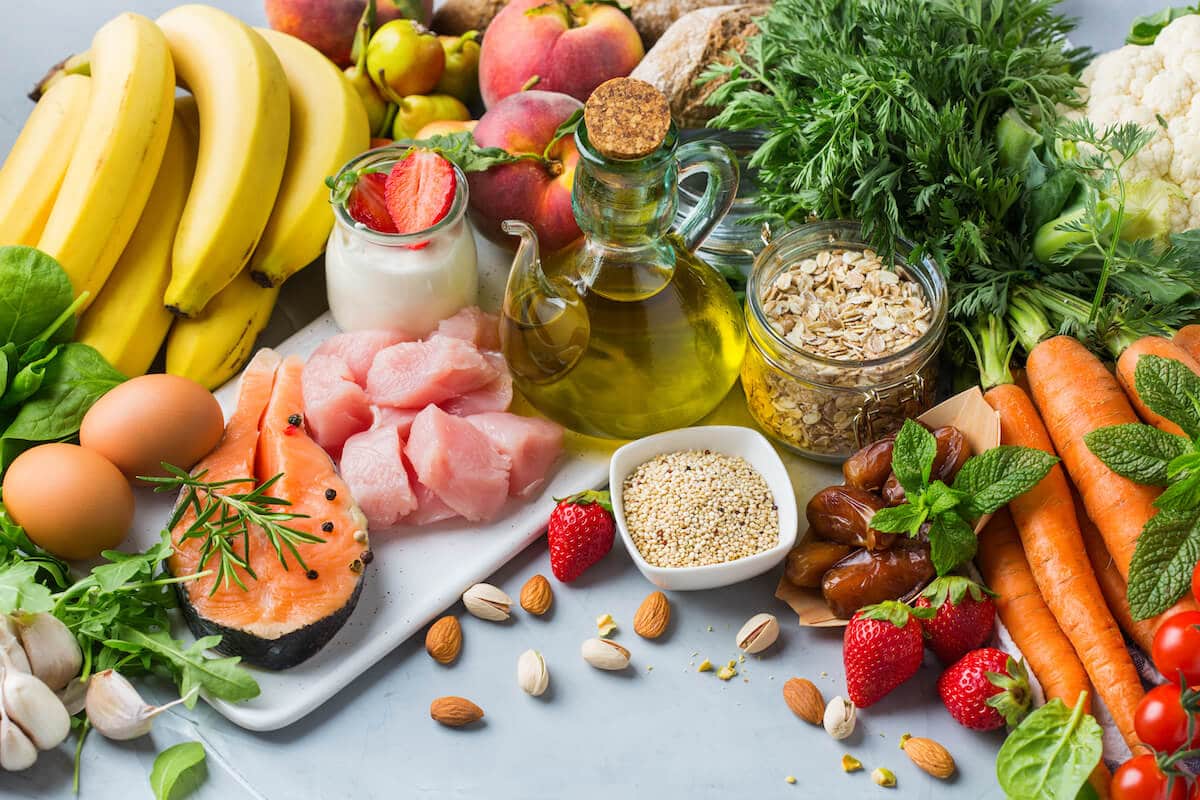
22 Nov How to Set Nutrition Goals for Your Health and Well-Being
If you’re looking to improve your overall health and well-being, an important part of that goal is to manage your eating habits. While crash diets sometimes show fast, short-term results, the real key to long-term health are small, sustainable changes. In short: Diets are out; smart nutrition goals are in.
Let’s explore what nutrition goals are and how to set them. We’ll start by identifying what a SMART goal looks like and then link that to healthy eating. We’ll also look at some examples of useful goals that could have you reaping health benefits for years to come.
What Are Nutrition Goals?
Despite all the advances of modern technology, getting access to wholesome food is still an issue for many people around the world, including the U.S. The irony is that even if you have enough to eat and you’re trying to manage your body weight by eating low-fat or diet foods, you may not be getting enough of the critical nutrients your body needs, and it’s quite possible to be technically malnourished.
On the other hand, if you choose foods that are packed with nutrients and you prepare them well, you could be eating delicious and nutritious food that actually nourishes your body at every meal. That keeps your body healthy and strong and gives you the energy you need to thrive during your busy day.
Nutrition goals help you stay on track with your food choices and eating habits. You could also call them healthy eating goals if that feels more comfortable for you.
Important notes:
- While a healthy diet creates a strong foundation for good overall health, other factors matter too. Along with nutrition goals, you might choose to set a few other health goals. For example, regular physical activity that you enjoy, managing your stress, and maintaining good relationships with those around you are all part of a healthy lifestyle.
- If you have a health condition and/or on medication, consult your healthcare practitioner or a registered dietitian before making changes to your diet. Nutrition goals should support your overall health, not work against it.
Why Do People Set Nutrition Goals?

People set health and nutrition goals for many different reasons. Perhaps you want to manage a chronic condition like type 1 or 2 diabetes, high blood pressure, or cholesterol — the risk of heart disease is always a good motivator. You may be carrying extra pounds and want to achieve a healthy weight. Or you might be struggling with tiredness or digestion issues, or perhaps you simply want to feel better in your body.
Achieving any of these longer-term goals requires setting everyday nutrition goals — smartly.
What Are SMART Goals?
SMART is an acronym that stands for Specific, Measurable, Achievable, Relevant, and Time-bound. SMART goals help us stay focused on getting where we want to go in a way that works for us.
Let’s take a look at that in a bit more detail using this SMART, longer-term goal — which definitely requires underlying nutrition goals — as an example:
- I want to reduce my total cholesterol to less than 200 milligrams per deciliter (mg/dl) within six months, so I can enjoy many healthy years ahead with my family.
Specific
Specific goals describe exactly what you’re trying to achieve and why. For example, rather than setting goals that are vague, like “be more healthy,” state exactly what aspect of your health you’d like to improve.
- In the example above, you’re being very clear that your goal is to reduce your cholesterol levels.
Measurable
Measurable goals are literally that — you can measure them objectively and even break them down into even smaller milestones. When you can see your progress, it helps you feel like you’re getting somewhere, which in turn motivates you to keep going.
- In our example, you’re aiming to reduce your total cholesterol to less than 200 milligrams, which is very measurable.
Achievable or Attainable
Achievable goals should feel realistic and attainable. They might be a challenge but if you aim too high — for example, to reduce your cholesterol to less than 200 milligrams in a week — you’ll probably give up on day one. Instead, aim for a goal you have a good chance of reaching.
- In the example, you’re giving yourself a good six months to reduce your cholesterol. If it’s not a lot higher than 200 milligrams, you’re likely to achieve that goal. If it’s quite a bit higher, you may need to give yourself longer.
Relevant
Relevant goals should feel worthwhile to you and link to the reason you’re setting the goal in the first place. There’s no point in aiming for something you don’t really care about or that makes no difference in your life. For example, if you’re not really interested in becoming a long-distance runner, you’re unlikely to be motivated by a goal of being able to run five miles a day.
- In the example above, the motivation is to be healthy enough to enjoy many healthy years ahead with your family.
Time-Bound
Time-bound goals have a target date attached to them that you can work towards. This keeps you focused when you’re tempted to let other, less important things take priority — like that piece of chocolate cake.
- In the example, you can set a specific date. If you start in the beginning of January, then your goal would be at the end of June.
Now that you know what a SMART goal is, let’s focus on the next part of this equation: healthy eating.
What Does Healthy Eating Look Like?

Healthy eating should be the foundation of your nutrition goals. According to dietary guidelines, a healthy diet incorporates all the major food groups, including protein, whole grains, dairy, fruit, and vegetables. Make these a part of your meal plans as well as in healthy snacks.
Let’s look at how you can work these healthy foods into your nutrition goals to support your longer-term health goals.
Some Examples of Smart Nutrition Goals
You might start by setting a longer-term goal like lowering cholesterol, blood sugar, or blood pressure, or reaching a healthy weight. But don’t stop there. Break that down into smaller, short-term — yet still SMART — goals that tell you exactly what you need to do each day or week. Then, track your progress against your longer-term goals each week or month, depending on what makes sense for you. The examples below may help get you thinking.
Protein
- At every meal, a quarter of my plate is filled with healthy protein
- For at least two meals a week, I replace meat with a plant-based protein
Protein supplies your body with the essential amino acids it needs to build its entire structure, from cells and hormones through to your bones, organs, and muscles. It also transports nutrients throughout your body, gives you energy, and helps you stay focused. And if your goal is weight loss, it keeps you feeling full so you don’t crave snacks all day.
You can get protein from animal products like beef, chicken, fish, eggs, or dairy, or from plant sources like legumes, quinoa, hemp, and chia seeds. If you’re struggling to get enough protein, consider supplementing with a high-quality protein supplement, like ioWhey Protein or Kaged Muscle Plantein. Both of these supplements contain Ingredient Optimized protein, with enhanced absorption so it delivers optimal nutrition.
Whole Grains
- For four meals a week, I replace starchy vegetables like potatoes with a healthy whole grain, like quinoa or brown rice
Whole grains should make up a quarter of your plate. They are fiber-rich carbohydrates that give you energy, lower your cholesterol, and keep your digestion working as it should be. They’re also excellent sources of the B vitamins, which support brain function, as well as other important nutrients. Look up how to cook interesting whole grains like quinoa, bulgur, or brown rice, and experiment to see what you like.
Fruits and Vegetables
- On weekdays, I fill at least half of my plate with fruit and/or non-starchy vegetables at every meal
- When I want a snack, I base it on fruit or vegetables
While some are more nutrient-packed than others, all fruits and veggies are excellent sources of a wide range of vitamins and minerals, which support many aspects of your health. They’re also high in all-important fiber, which keeps your digestive system working well.
Try to eat a selection of fresh fruits and veggies over the course of the day to make sure you’re getting all the nutrients you need — eat the rainbow, as the saying goes.
Some great healthy snacks are a salad with a dash of balsamic vinegar plus olive oil to provide some healthy fats, an apple with cottage cheese, or celery with peanut butter. Or try a delicious smoothie made with banana, raspberry, yogurt, and ioProtein.
As a bonus, dairy products like cottage cheese or yogurt give you a good dose of calcium to keep your bones and teeth strong and keep your heart pumping. Dairy is also full of antioxidant-rich, immune-boosting vitamin A, as well as vitamin B12, which helps reduce your risk of cardiovascular disease.
Other Helpful Nutrition Goals
These nutrition goals will help you stay on track:
- Every time I want a soft drink, I drink water instead: You can make that water more interesting by adding lemon, cucumber, berries, and/or mint.
- Every weekend I plan my meals for the week ahead and shop for the ingredients: When you have a plan and the ingredients on hand, you’re less likely to open the fridge and grab whatever’s easiest.
- When I cook healthy food, I always make enough for two meals and freeze one: Having a healthy, homemade meal on hand that you can simply heat up makes it less likely that you’ll order take-out after a hectic day.
- Every week, I try two new recipes that make vegetables interesting: You could get a vegetable cookbook or look up recipes online — there’s no shortage of those.
What to Avoid as Part of Your Nutrition Goals
On the other side of the equation, you’ll want to avoid processed food and anything that contains:
- Added sugar
- Artificial sweeteners
- Artificial colors or flavors
- Preservatives
- Heavy metals
- Pesticides
Clear those out of your house, then keep a sharp eye out when you shop. You’ll be surprised how many supposedly healthy foods contain these ingredients. If you do buy pre-prepared foods, be sure to read the ingredients list.
Or better yet, focus on healthy, whole foods that you prepare yourself at home. There are plenty of very simple recipes out there that are quick and easy to make, and taste absolutely delicious.
Nutrition Goals Can Boost Your Health and Well-Being
Nutrition goals help you make powerful and sustainable changes to your eating habits and your overall health.
Your nutrition goals should be SMART — specific, measurable, achievable, relevant, and time-bound. They should also be based on healthy food choices, with the right proportions of protein, whole grains, dairy, and fresh fruits and vegetables, plus high-quality supplements when necessary.
Start your plan and if need be, adjust as you go. You may find yourself feeling a whole lot better much sooner than you think.


